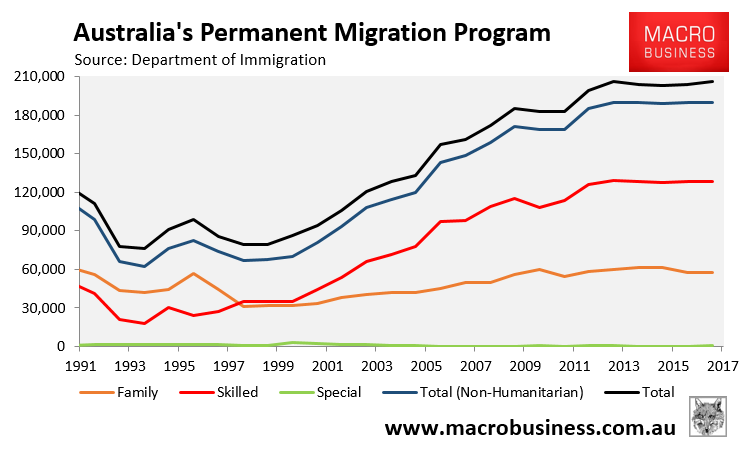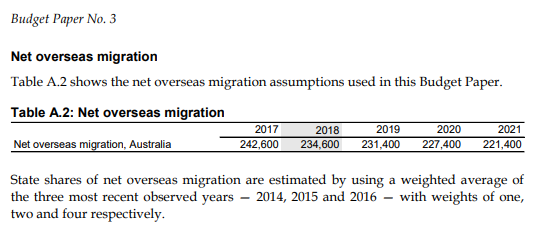In years gone past, the Federal Budget gave us a clear indication of the size of Australia’s immigration program for the year ahead by explicitly publishing the intake. Now that figure seems to be hidden somewhere deep inside Immigration Minister Peter Dutton’s skull.

I’ve spent a good hour this morning scouring the Budget papers, the Home Affairs website, ministerial releases, and so forth, and have not been able to find any information on Australia’s planned migration program for 2018-19. It might be there somewhere, but the Government has done a great job hiding the figure.
All that I have found is a Howard-era ‘bait and switch’ proclaiming that this Budget will “Keep Australia Safe” by making “investments to further secure our borders”:

As well as the below chart projecting that net overseas migration (NOM) will remain at insanely high levels above 220,000 over the forward estimates:

The Australian’s Judith Sloan claims the Government will keep the non-humanitarian migrant intake unchanged at 190,000 (in addition to 18,000 humanitarian places) and has attacked the Coalition’s intransigence to lower the number but it’s not clear where he number came from:
The first thing you need to know is there is no change in this budget to the number of permanent immigrants allowed into the country over the next four years. It remains at the very high annual figure of 190,000.
Clearly the “wets” in the cabinet (and that is most of them) couldn’t bring themselves to reach the obvious conclusion that the migrant intake is excessive and is causing all sorts of problems, particularly in Melbourne and Sydney. The fact that there are a number of entirely inadequate and disruptive “congestion busting” measures contained in the budget indicates that the government knows the perceived, rapid loss of urban amenity is an issue in the electorate.
But at the end of the day, the Treasurer was not prepared to sacrifice any of the figures contained in the major economic parameters that underpin the budget estimates and projections.
With its refusal to lower immigration, the Coalition has made its job of winning the next election all the more difficult.
Public opinion has overwhelmingly shifted towards lowering immigration. The three most recent opinion polls on the matter from the Australian Population Research Institute (54% want lower immigration), Newspoll (56% want lower immigration), and Essential (54% believe Australia’s population is growing too fast and 64% believe immigration is too high) all show that the majority of Australian voters support lowering immigration.
Not only is it sound policy to lower immigration, given the severe indigestion being experienced in the major cities (let alone damage to the natural environment), but there are also several political advantages for the Coalition, namely:
- It would wedge Labor on housing affordability making negative gearing cuts more scary for voters now and pushing house prices down further when the reform is introduced.
- It would wedge Labor on wages and help counter its inequality agenda.
- It would wedge Labor on national security and further expose the scandal around Labor links to the Chinese Communist Party.
- It would wipe out One Nation, which currently owns the lower immigration debate among conservative voters.
- If Labor does win the next election, it would force it to explicitly raise the permanent migrant intake back up (rather than merely maintain it), which would be very unpopular among voters.
Refusing to follow the wishes of the Australian people and lower the permanent migrant intake is a major strategic blunder that it will pay for at the ballot box.

